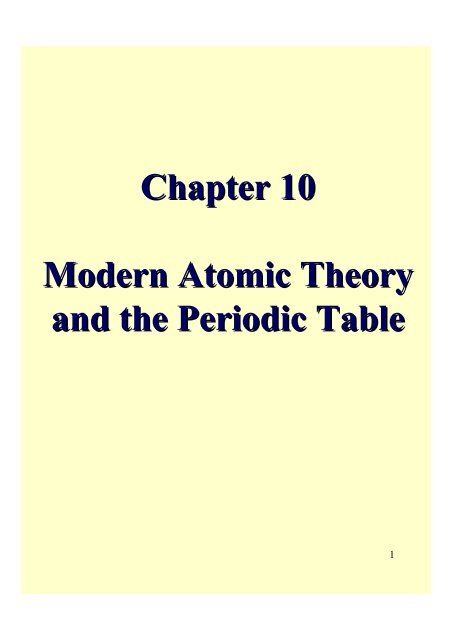Chapter 10 Modern Atomic Theory and the Periodic Table
Chapter 10 Modern Atomic Theory and the Periodic Table
Chapter 10 Modern Atomic Theory and the Periodic Table
- No tags were found...
Create successful ePaper yourself
Turn your PDF publications into a flip-book with our unique Google optimized e-Paper software.
<strong>10</strong>.1 A brief history<strong>10</strong>.1 A brief historyatoms proposed by Greek philosopherDalton’s model of atomThomson’s modelRu<strong>the</strong>rford’s model<strong>the</strong>re remain questions can not be answered:․ how atomic structure relates to <strong>the</strong> periodictable (arrangement of electrons)․ how to explain line spectrum of atom2
<strong>10</strong>.2 Electromagnetic radiationenergy <strong>and</strong> light – energy travels through space isby electromagnetic radiation,all radiations travel at <strong>the</strong> same speed –v = λ • υ = 3 × <strong>10</strong> -8 m/sλ : wavelengthυ : frequencyelectromagnetic spectrumwavelike nature -- radiationbehaves like particle -- photonexplain <strong>the</strong> properties of electromagneticradiation by both wave <strong>and</strong> particle properties3
<strong>10</strong>.3 The Bohr atomat high temperature or when subjected to highvoltage, elements in <strong>the</strong> gaseous state give offcolored lighta set of brightly colored lines – line spectrumex. line spectrum of hydrogenline spectrum indicates that light is being emittedonly at certain wavelength (or frequency)1912 Bohr model of hydrogen• electrons exit in specific regions at variousdistance from <strong>the</strong> nucleus• <strong>the</strong> electrons as revolving in orbits around <strong>the</strong>nucleus like planets rotating around <strong>the</strong> Sun4
Max Planck energy quanta<strong>the</strong> energy is never emitted in a continuousstream but only in small discrete packets calledquantaelectrons are only in several energy levelshydrogen atom absorbs one or more quanta ofenergy, <strong>the</strong> electron will jump to a higher energylevelground state– <strong>the</strong> lowest energy levelexcited states– <strong>the</strong> higher energy levelswhen an electron falls from a high-energy levelto a lower one, a quantum of energy is emittedas light at a specific frequencyBohr model1) suggesting quantized energy levels for electrons2) showing that spectral lines result from <strong>the</strong>radiation of small increments of energy whenelectrons shift from one energy level to ano<strong>the</strong>rhowever, Bohr model only succeeded in H atom,5did not succeed for heavier atoms
1924 de Broglie all objects have wave propertiesfor small objects such as an electron, <strong>the</strong> waveproperties become significant1926 Schrödinger Schrödinger equationa ma<strong>the</strong>matical model that described electronsas waves<strong>the</strong> probability of finding an electron in a certainregion around <strong>the</strong> atom can be determinedwave mechanics or quantum mechanicsforming <strong>the</strong> basis for our modern underst<strong>and</strong>ingof atomic structurewe cannot locate an electron precisely within anatomelectrons are not revolving around nucleus inorbits as Bohr postulatedorbital a region where a high probability offinding a given electron6
<strong>10</strong>.4 Energy levels of electronBohr <strong>the</strong> energy of <strong>the</strong> electron is quantized<strong>the</strong> electron is restricted to only certainallowed energieswave-mechanics also predicts discrete principalenergy levels within <strong>the</strong> atom<strong>the</strong>se energy levels aredesignated by <strong>the</strong> letter nn: positive integeras n increases, <strong>the</strong> energy of <strong>the</strong> electronincreases, <strong>and</strong> <strong>the</strong> electron is found on averagefar<strong>the</strong>r from <strong>the</strong> nucleuseach principal energy levelis divided into sublevelsn = 1n = 2n = 31 sublevel2 sublevels3 sublevelseach of <strong>the</strong>se sublevels contains space forelectrons called orbitals7
n = 1 1s orbital spherical shape<strong>the</strong> electron does not move around on <strong>the</strong>surface of sphere, <strong>the</strong> surface encloses a spacewhere <strong>the</strong>re is a 90% probability that <strong>the</strong>electron may be foundhow many electrons can fit into a 1s orbital?spin a property of electroneach electron can only spin in two directionsrepresentation of <strong>the</strong> spin ↑ or ↓two electrons with <strong>the</strong> same spin cannot occupy<strong>the</strong> same orbitalPauli exclusion principle – an atomic orbitalcan hold a maximum of two electrons whichmust have opposite spinsn = 1 energy level contains one type of orbital(1s) that hold a maximum of 2 electronsn = 2 2s spherical shapehold a maximum of two electrons2p – 2p x , 2p y , 2p z8
each p orbital has two lobes <strong>and</strong> can hold amaximum of two electrons<strong>the</strong> total number of electrons that can reside inall three p orbitals is 6n = 3n = 2 energy level contains two types oforbitals (a 2s <strong>and</strong> three 2p) that hold amaximum of 8 electrons3s3p – 3p x , 3p y , 3p z3d – 3d xz , 3d xy , 3d yz , 3d z 2, 3d x 2 –y 2n = 3 energy level contains three types oforbitals (a 3s, three 3p, five 3d) that hold amaximum of 18 electrons9
valence electrons – <strong>the</strong> electrons un <strong>the</strong> outmost(highest) energy level of an atomex. O 1s 2 2s 2 2p 4 6 valence electrons12Mg 1s 2 2s 2 2p 6 3s 2 2 valence electrons
<strong>10</strong>.6 Electron structures <strong>and</strong> <strong>the</strong> periodictable1869 Mendeleev & Meyerperiodic arrangements of <strong>the</strong> elements based onincreasing atomic massesperiodic tableperiod – horizontal row<strong>the</strong> outmost energy levelgroup or family – vertical columnelements behave in a similar mannerIA ~ VIIA, IB ~ VIIB, VIII, noble gases1 ~ 18representative elements – A group elementstransition elements – B group elementsIA – alkali metals IIA – alkaline earth metals13VIIA – halogens
<strong>the</strong> valence electron configurations for H ~ Ar• <strong>the</strong> valence electron configuration for <strong>the</strong>element in each column is <strong>the</strong> same, but <strong>the</strong>number for <strong>the</strong> energy level is different• <strong>the</strong> chemical behavior <strong>and</strong> properties of elementsin a particular family are similar <strong>and</strong> must beassociated with <strong>the</strong> electron configurationabbreviated electron configurationB 1s 2 2s 2 2p 1 [He] 2s 2 2p 1Cl 1s 2 2s 2 2p 6 3s 2 3p 5 [Ne] 3s 2 3p 5Na 1s 2 2s 2 2p 6 3s 1 [Ne] 3s 1n = 4 K 1s 2 2s 2 2p 6 3s 2 3p 6 4s 1 [Ar] 4s 1Ca 1s 2 2s 2 2p 6 3s 2 3p 6 4s 2 [Ar] 4s 2element 21 ~ 30 transition elementselectrons are placed in <strong>the</strong> 3d orbitals14
arrangement of elements according to <strong>the</strong>sublevel being filledinner transition elementslanthanide series –4factinide series –5fex. <strong>10</strong>.1 write <strong>the</strong> electron configuration forP <strong>and</strong> SnP 1s 2 2s 2 2p 6 3s 2 3p 3 [Ne]3s 2 3p 3Sn 1s 2 2s 2 2p 6 3s 2 3p 6 4s 2 3d <strong>10</strong> 4p 6 5s 2 4d <strong>10</strong> 5p 2[Kr] 5s 2 4d <strong>10</strong> 5p 215
groups of elements show similar chemicalproperties because of <strong>the</strong> similarity of <strong>the</strong>seoutmost electron configurations<strong>the</strong> periodic table illustrates several importantpoints:1. <strong>the</strong> number of <strong>the</strong> period corresponds with<strong>the</strong> highest energy level occupied byelectrons2. <strong>the</strong> group numbers for <strong>the</strong> representativeelements are equal to <strong>the</strong> total number ofoutmost electrons in <strong>the</strong> atom3. <strong>the</strong> elements of a family have <strong>the</strong> sameoutmost electron configuration, but indifferent energy level4. <strong>the</strong> elements within each of <strong>the</strong> s, p, d, fblocks are filling <strong>the</strong> s, p, d, f orbitals5. within <strong>the</strong> transition elements some 16discrepancies in <strong>the</strong> order of filling occur











![Hetero [6+3] Cycloaddition of Fulvenes with N-Alkylidene Glycine ...](https://img.yumpu.com/35423358/1/190x245/hetero-6-3-cycloaddition-of-fulvenes-with-n-alkylidene-glycine-.jpg?quality=85)




